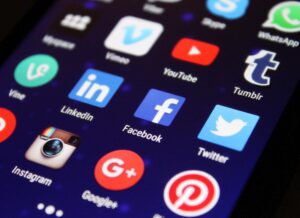Social media is a powerful tool that allows us to communicate, share information and interact with one another in ways that were not possible before. This powerful tool can be used effectively for marketing.
Social media is a part of your life now, whether you like it or not. Social media platforms have become the go-to place for information, entertainment, and socializing.
These platforms have become integral in our everyday lives, so much so that social media has become a part of how we communicate with each other, from a simple “hi” or “thank you” to an entire post.
According to research by smartinsights.com, 58.4% of the world’s population uses social media with an average daily usage of about 2 hours 27 minutes.
Social media has also changed the ways we market ourselves, our businesses, and our brands to attract new customers and drive sales.
Your target audience is your audience, and that includes social media users. But what makes some social media users more engaging than others? Why are some posts more compelling than others? Answers to these questions posed above are the factors that influence social media engagement.
What is social media engagement?
Social media engagement is the process of interacting with potential or current customers on social media platforms like Facebook, Twitter, and LinkedIn. It can also be said to be a measure of how many users interact with your content.
The more engaging your content is, the more likely users are to share it. If the content is popular, it’s more engaging, i.e., it’s getting more engagement than less popular content.

Engagement is a ranking signal on all social media platforms. If people engage with your content, the algorithm will see that content as interesting and valuable, and surface it to more users. This means that social media engagement can help you grow your social accounts and reach more people.
Social media engagement is influenced by a number of different things, but depending on if a company is smaller or larger than its competitors, engagement may be high or low, thus affecting sales and performance.
Seven factors that influence social media engagement include
- Audience – Whom Are You Influencing?
- Content – What Will You Share?
- Promotion – Where Will You Share It?
- Frequency – How Often Will You Share?
- Time – When Will You Share It?
- Personal – Are You Authentic?
- Optimization: Optimize your posts
-
Audience – Whom Are You Influencing?
It’s important to think about who your audience is when you’re trying to engage them on social media. What is the age gender and location of your audience? Answering these questions will help you choose the right social media platform to be in so as to be in front of the right audience for you.
Understanding who your audience is, what they want, and where they are will help you know if they are with you to learn or if they are trying to take action. Whatever your goal is, it’s important to understand who your audience is and what they want. Only then can you truly influence them.
Being on the right platform for your audience will help you to have a lot of active followers or organic followers, thereby increasing you’re likely to see more engagement than if you have a smaller, less active group. Keep this in mind when you’re creating content and planning your social media strategy.
An audience is more than a collection of people. When an audience is created, it is necessary to put more effort into adding value to the audience, rather than selling to an audience.
As a content creator, you probably spend a lot of time thinking about how your content will be perceived. But, depending on what you’re promoting, that perception could mean the difference between readers and followers, and between success and failure.
-
Content – What Will You Share?
If you’re not sharing content that is engaging, then you’re not going to get much engagement from your social media followers. If you are promoting a blog post, make sure the headline is catchy and entices the reader to want to learn more. The same goes for promoting a product or service – make sure the offer is clear and concise so that people know what they are getting.

Make sure that the content you are sharing is interesting, informative, or entertaining. Also, be sure to mix up the content you share so that you’re not always sharing the same type of thing.
Are you looking for interesting and engaging things to share on your social media platforms? Just like every marketer, you want your content to be attention-grabbing and useful to your audience. But what kind of content should you share?
There are many different types of content you can share on social media, which include videos, photos, blog posts, GIFs, and infographics. But it’s important to remember that not all content is created equal. You’ll need to consider what kind of content is most likely to resonate with your audience and achieve your desired objectives.
-
Promotion – Where Will You Share It?
This is a great question to ask when you are considering how to best promote your business. There are many places where you can share your business, but not all of them will be equally effective. It is important to consider your audience and where they are most likely to see your promotion.
For example, Facebook is great for B2C companies because that is where their target market is spending the majority of their time. However, LinkedIn would be a better platform for B2B companies since that is where professionals are more engaged.
The social media platform you have chosen depending on whom your audience is also has a way of determining what best to post. Below is a general guideline on what to post on each social media platform.
- Facebook: Videos and curated content.
- Instagram: High-res photos, quotes, Stories.
- Twitter: News, blog posts, and GIFs.
- LinkedIn: Jobs, company news, and professional content.
- Pinterest: Infographics and step-by-step photo guides.
Where you promote your content has an impact on how much engagement you get. If you share your content on multiple channels that are right for your content.
The type of content you produce has a lot to do with where you shear it because the audience on each social media platform has what they prefer and this is one of the major reasons you find them on that platform.
-
Frequency – How Often Will You Share?
Although growing your presence on social media is important, you must also take care to maintain it. If you only share once in a while, then you’re not going to stay top of mind with your followers and they’re not going to engage with your content.
Make sure you’re sharing regularly, but not so much that you’re becoming a nuisance. Find a happy medium where you’re sharing enough that your followers will see your content, but not so much that they get overwhelmed and tune you out.
Regularly posting high-quality content across social media profiles will establish you as a devoted, persistent, and helpful brand in the eyes of your audience. How frequently you post also have something to do with the social media platform you are using.
According to research by louisem.com, it is suggested that you post as follows:
- Instagram, post 1-2 times daily.
- Facebook, post once daily.
- Twitter, post 15 Tweets daily.
- LinkedIn, post once daily.
- Pinterest, post 10 pins daily.
- TikTok, post 3 times daily.
Understanding your platform and followers will help you develop a proper schedule for them. Where once you make a post or a particular kind of post, the audience that is anticipating will more likely be engaging. This is because you put up something they were waiting for.
-
Time – When Will You Share It?
Typically, the best time to share on social media is when you have the most engaged followers. This is usually because they are most likely to see your content and interact with it.
Sproutsocial.com found that the highest times of engagement and best times to post on social media overall are Tuesdays through Thursdays at 9 a.m. or 10 a.m. Midweek mornings proved to be a successful time across most social platforms.
This makes a lot of sense when you think about it from a psychological standpoint. People are more likely to be in a good mood and have free time midweek when they’re not bogged down by the start of the work week or the weekend.
Since social media is meant to be a fun and lighthearted way to connect with others, the positive energy of midweek mornings is the perfect time to get people engaged.

When looked at individually, each network had different levels of engagement throughout the week, and at very different times. And when industries are factored in, engagement varies even more.
- The best times to post on Facebook are early mornings from Monday to Friday, and at 10 a.m. and noon on Tuesdays.
- The best times to post on Instagram are Mondays at 11 a.m., Tuesdays and Wednesdays from 10 a.m. to 1 p.m., and Thursdays and Fridays from 10 a.m. to 11 a.m.
- The best times to post on Twitter are Mondays, Tuesdays, Wednesdays, Fridays, and Saturdays at 9 a.m.
- The best times to post on LinkedIn are Tuesdays from 10 a.m. to noon.
Timing is very important – share when your followers are most likely to be online and interacting which of course, depends on your specific audience. For example, if you are targeting working mothers, the best time to share would be in the evening, after they have put their kids to bed.
Experiment with different times and days to see when you get the most engagement from your followers.
-
Personal – Are You Authentic?
Having a lot of active followers is one factor that can influence social media engagement, but it’s not the only one. Being authentic is another big factor. People are more likely to engage with you on social media if they feel like they know you and can trust you.
If you’re always posting things that are fake or trying to sell something, people will be less likely to engage with you. Being authentic doesn’t mean that you can’t sell things on social media, but it does mean that you should focus on building relationships with your followers first.
If you can do that, you’ll likely find that they’re more interested in what you have to say and more likely to buy from you in the future. Also, the more you post, the more likely people are to see your content and engage with it.
If you post interesting, relevant content that’s tailored to your audience, you’ll see higher engagement levels. Try to be as active as possible. Like and comment on other people’s posts, join in conversations and run social media contests. The more you interact with other people, the more likely they are to interact with you.
-
Optimization- Optimize your posts
Optimization is key when it comes to social media marketing. By optimizing your posts, you can ensure that your content is seen by more people, which can lead to increased engagement and conversions. Here are some tips on how to optimize your posts:
- Use relevant keywords in your posts.
- Use hashtags to reach a wider audience.
- Share your content at the best times.
- Use images and videos to make your posts more engaging.
- Use catchy captions to draw readers to your post
By following these tips, you can optimize your posts for better engagement and conversions. The more you optimize your posts, the wider their reach will be and the higher the engagement.
Why is social media engagement important?
Engagement on social media provides valuable insights into how your content is being received by your target audience. By taking social media engagement into account when planning your content, you can make sure that you are catering to your audience’s needs and expectations.
The purpose of social media engagement is to build relationships, trust, and loyalty with customers. Building a social media following takes time and effort, but it can be extremely rewarding. Once you have a solid base of engaged followers, you’ll be able to reach even more people and continue to grow your business.
The importance of social media engagement includes:
- Build brand awareness
- Increase social traffic
- Drive traffic back to your website
- Build relationships with customers
- Increase sales
- Grow your social media following
- Generate leads
Drivers of social media engagement
According to emerald.com, there are five drivers of social media engagement and they are:
- Connected effect
- Network effect
- Information effect
- Dynamic effect
- Timeliness effect
In conclusion, the significant user base and increased engagement on social media channels will contribute to the growth of your business. The key is to prioritize customers’ interests and encourage them to stay connected.
The number of active followers you have will play a big role in ensuring that your social media engagement is high. If you have a lot of followers who are constantly interacting with your posts, this will show potential customers that you are an authority in your industry. This will make them more likely to do business with you.
By addressing the concerns mentioned above, you can be sure that your audience will remain invested in your brand and more engaged with your content.




Thank you for the quality article on Social media marketing. Keep up the good work.